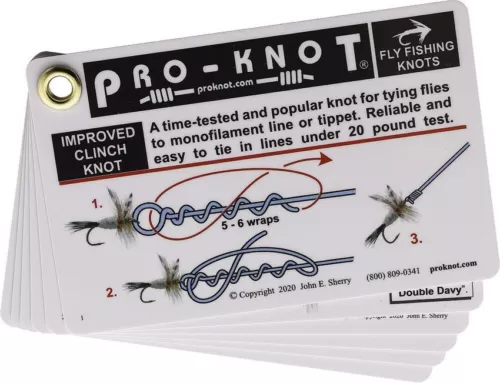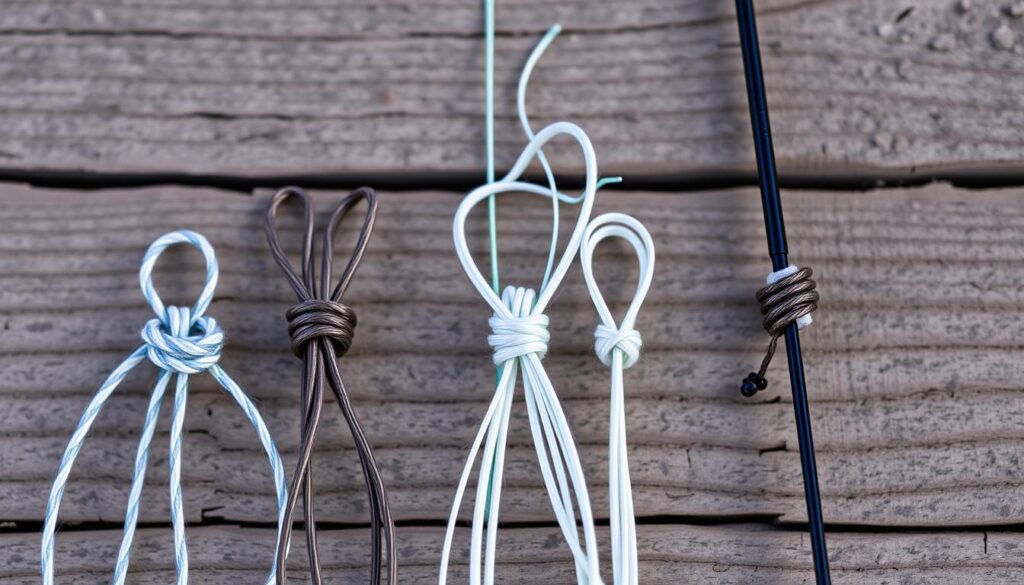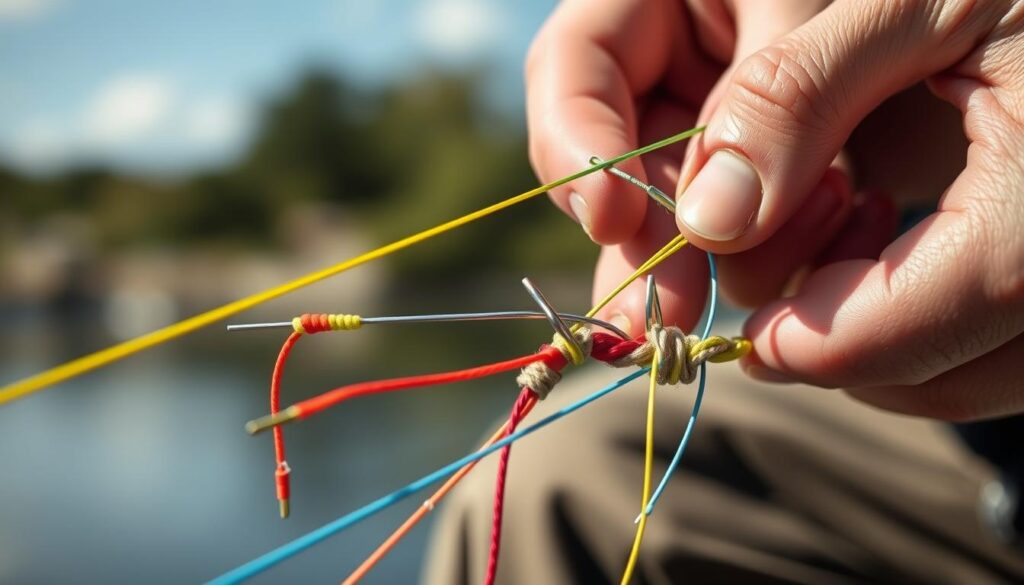Physical Address
304 North Cardinal St.
Dorchester Center, MA 02124
Physical Address
304 North Cardinal St.
Dorchester Center, MA 02124

Fishing is a favorite hobby for many, and knowing how to tie fishing knots is key to doing well. This guide covers a wide range of fishing knots, from simple to complex. It aims to help anglers of all levels improve their skills and catch more fish.
Fishing knots are key to successful fishing trips. They keep your line strong and your catch secure. Learning to tie knots is crucial for every angler.
A good knot can mean the difference between catching your dream fish or losing it. Fishing knots stop lines from breaking under fish pressure. Knowing how to tie different knots for fishing helps you adapt to various fishing situations.
This knowledge also lets you change your setup for different fishing types. Whether you’re fishing in freshwater, saltwater, or with fly fishing gear, having the right knots makes your setup better suited for your target fish and the conditions.
Staying ahead in fishing means improving your knot tying skills. Mastering how to tie knots and how to make knots prepares you for unexpected challenges. This increases your chances of success and makes fishing more rewarding.
Connecting your fishing line to a hook is crucial. It needs to be done securely. Learning a few key knots can help keep your hooks on your line, even when big fish strike.
We’ll look at three important knots for attaching line to hooks: the improved clinch knot, the uni knot, and the Palomar knot. Each has its own benefits and fits different fishing situations.
Learning these essential knots will help keep your hooks on your line. With the right skills, you’ll catch more fish and have a better fishing experience.
Anglers often need to join fishing line sections or create loops for tackle. Luckily, there are several knots for these tasks. We’ll look at three key knots: the double surgeon’s knot, the blood knot, and the improved clinch knot.
The double surgeon’s knot is great for joining lines of the same size. It’s simple to tie and creates a strong bond. This makes it a top choice for connecting fishing line or leader materials. To tie it, overlap the lines, pass one end through the loop twice, then the other end through the same loop twice before tightening.
The blood knot is another good option for joining fishing lines. It works well when switching from a thick main line to a thinner leader. To tie the blood knot, overlap the lines, wrap one end around the other several times, then do the same with the other end. Finally, pull the ends tight.
The improved clinch knot is great for making loops at the end of a fishing line. It’s often used with swivels, lures, or other tackle. To tie it, pass the line through the hook’s eye, wrap the tag end around the line, then pass the tag back through the first loop and the hook’s eye before tightening.
Learning these knots for joining lines and creating loops lets anglers connect their gear with confidence. These knots are essential for a successful fishing trip, whether in freshwater or saltwater. They secure your tackle and keep your line in place.
| Knot | Description | Applications |
|---|---|---|
| Double Surgeon’s Knot | A strong knot for joining two lines of similar diameter | Connecting fishing line or leader materials |
| Blood Knot | Effective for joining lines of slightly different diameters | Transitioning from main line to leader |
| Improved Clinch Knot | Creates a loop for attaching terminal tackle | Connecting swivels, lures, and other terminal tackle |
Fishing lines come in many types, each with its own needs for tying knots. Anglers need the right skills to attach these lines to hooks and other gear. This ensures a strong and reliable connection, no matter the line type.
Monofilament and fluorocarbon lines need special knot tying techniques to stay put and keep their strength. The improved clinch knot and palomar knot are top picks for these lines. They are simple and reliable. Practicing these knot tying methods is key for a secure connection with monofilament or fluorocarbon lines.
Braided fishing lines are tricky when it comes to tying knots. Their smooth surface can make knots slip. But, the uni knot and double uni knot can solve this problem. They offer a strong hold and consistent performance with braided lines.
For anglers using wire line, learning special knot tying skills is a must. The blood knot and crazy alberto knot are great for attaching wire line to hooks and leaders. With practice, anglers can get these fishing knot techniques down. This ensures their gear stays securely in place.

Knowing how to tie knots for different line types helps anglers use their gear better. Mastering these knot tying skills is crucial for becoming a skilled angler.
For new anglers, the world of fishing knots can be daunting. But don’t worry, this part is all about easy-to-learn knots. These knots are simple yet strong, perfect for beginners.
The improved clinch knot is a must-know for beginners. It’s reliable and easy to tie, great for attaching fishing line to a hook. The uni knot is also handy, useful for joining lines or making a secure loop.
Learning the improved take knot is a big plus for new anglers. It’s great for connecting a leader to your fishing line. With clear instructions and pictures, beginners can improve their knot-tying skills. This makes fishing more enjoyable and successful.
By starting with these easy fishing knots, beginners can build a strong knot-tying foundation. This sets them up for success in fishing.
Fly fishing is a unique challenge for anglers. It requires a set of knots to keep the fly line and tippet attached securely. We’ll look at the key knot tying techniques and fishing knots every fly angler needs to know.
The improved clinch knot is crucial for fly fishing. It connects the fly to the tippet, making a strong and reliable bond. This knot can handle the demands of casting and fighting fish. Here’s how to tie it:
The surgeon’s knot is another key knot for fly fishing. It joins lines together, like the fly line and leader, or the leader and tippet. This knot keeps the connection strong while allowing flexibility for casting. Here’s how to tie it:
The loop-to-loop connection is also important for fly anglers. It makes linking the fly line and leader quick and easy. This lets you change leaders or tippets easily on the water. To do this, just make loops at the end of each line and pass one through the other.
Learning these fly fishing knots and techniques will improve your casting accuracy and hooksets. It also ensures a secure connection between your line and tackle. With practice, you’ll tie these knots confidently, making your fly fishing trips more successful and fun.
Saltwater fishing is tough, with heavy tackle and strong fish. It also has corrosive saltwater. To catch fish successfully, you need knots that can handle these challenges. This section covers the key saltwater fishing knots for coastal and offshore fishing.
For fishing knots in saltwater, the improved albright knot, slim beauty knot, and spider hitch are top picks. These knot tying methods offer the strength and reliability needed for big catches in harsh saltwater.
These fishing knot techniques are crucial for any serious saltwater angler. They help land the big ones. With practice, anglers can become experts in these knot tying skills, improving their saltwater fishing.
| Knot | Description | Best Use |
|---|---|---|
| Improved Albright Knot | A secure connection between fishing line and wire or monofilament leaders | Attaching leader to mainline |
| Slim Beauty Knot | Versatile knot for joining different line materials | Connecting mainline to leader or tippet |
| Spider Hitch | Creates a strong loop for attaching hooks, lures, or swivels | Terminal tackle connections |
Knot tying is key for any angler wanting to catch fish with confidence. It’s vital whether you’re experienced or new to fishing. Learning to tie knots can greatly improve your fishing success. This guide will cover various knots and techniques to make you a pro at tying knots.
First, let’s cover the basics. Knowing how to tie the overhand knot and the improved clinch knot is crucial. These knots are the building blocks for more complex techniques. With practice, tying these knots will become second nature, ensuring a strong line connection every time.
Exploring fishing knots reveals many specialized ones for different lines and fishing situations. The Palomar knot is great for monofilament lines, while the Albright knot works well with braided lines. These knots help you manage various line types and create strong connections for fishing.
Fly fishing requires its own set of knots, like the perfection loop and the surgeon’s knot. These are vital for attaching leaders, tippets, and flies to your line. They make fly fishing smooth and efficient.
Saltwater fishing puts knots to the test. Knots like the Bimini twist and the Slim Beauty are made for the stress of offshore fishing. They provide the strength needed to catch big fish.
No matter your fishing style or where you fish, tying knots is crucial. It will improve your fishing skills and make your time on the water more successful and fun. This guide will help you become a knot-tying expert, boosting your fishing abilities.

Tenkara fishing is a traditional Japanese method that needs special knots for its lightweight lines and delicate tippets. This part talks about the key Tenkara knots. You’ll learn about the improved clinch knot, the double surgeon’s knot, and the bow and arrow knot. These techniques are vital for Tenkara fishing, making sure your tackle stays securely attached for a great day fishing.
The improved clinch knot is great for attaching the line to the hook, offering a strong connection. The double surgeon’s knot is ideal for joining lines of different sizes, which is often needed when switching from the main line to a thinner tippet. The bow and arrow knot helps create a loop at the line’s end. This makes it easy to attach flies or other tackle.
Learning these key Tenkara knots ensures your line and tackle stay securely attached, even in tough fishing conditions. With practice, these knot tying skills will become easy, making your Tenkara fishing better.
Learning to tie tying knots is key for any serious fisher. It’s not just about the technique. It’s also about making your fishing knots strong and durable. By using a few simple tips, you can make sure your knots stay secure and reliable, even when a big fish bites.
To make strong, lasting knots, lubricate them before tightening. Use saliva, water, or a special lubricant to reduce friction and help the knot tying process. Also, make sure to pull the knots tight with your fingers or pliers.
After securing the knot, trim any extra tag ends close to the knot. This makes your tackle look better and prevents the tag ends from catching on things and weakening the knot later.
By following these easy knot tying tips, anglers can be sure their connections are strong and reliable. This means a successful and fun day fishing.
This guide includes detailed knot animations and illustrations to help you learn fishing knots. These visuals make the instructions clear and easy to follow. They show you how to tie each knot properly.
Knot animations and illustrations are a big help in this guide. They let you see the techniques in action. By watching how each tying knots, fishing knots, and knot tying method is done, you can learn to do it yourself.
The animations show the detailed movements needed for secure connections. Whether it’s tying a knot, tying fishing line, or learning fishing knot techniques, these visuals are key. They’re great for both new and skilled anglers wanting to improve their knot tying skills.
This guide also has detailed knot illustrations. These let you see each knot up close. They help you make sure you can tie them correctly on the water.
If you’re just starting or if you’re an experienced angler, these animations and illustrations are very useful. They’re a great way to learn how to tie knots and how to make knots for fishing. Dive in and use these visual guides to become a pro at tying knots.
Learning to tie knots and fishing knots is key for all anglers, from beginners to pros. This guide has shown many important knots, from simple ones to those for fly fishing and saltwater. By mastering these, anglers can make their fishing gear more reliable, catch more fish, and have a better time fishing.
This article has given anglers the confidence to tie the right knot for any fishing trip. It covers how to tie knots, fishing knot techniques, and knot tutorials. Now, readers have the skills to be confident and successful in their fishing adventures.
If you’re just starting or if you’re an experienced angler, this guide is a great resource. It’s a complete angler’s knot guide for fishing knots and knot books. With these skills, you’ll improve your fishing and enjoy the excitement of catching fish.
I’m an Amazon Affiliate